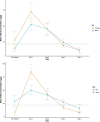Blood cortisol and faecal cortisol metabolite concentrations following an ACTH challenge in unanaesthetized brown bears (Ursus arctos)
- PMID: 39816213
- PMCID: PMC11734623
- DOI: 10.1093/conphys/coae093
Blood cortisol and faecal cortisol metabolite concentrations following an ACTH challenge in unanaesthetized brown bears (Ursus arctos)
Abstract
Faecal cortisol metabolites (FCMs) are increasingly used to index physiological stress in wildlife. Cortisol and other stress hormones act to mobilize glucose, providing energy for the organism to respond to environmental perturbations. Cortisol, the predominant glucocorticoid (GC) in most mammals, is metabolized by the liver and excreted as FCMs. For FCMs to serve as a meaningful physiological index of stress in brown bears (Ursus arctos), we sought to quantify the relationship between blood cortisol and FCM concentrations. Consequently, we conducted an adrenocorticotropic hormone (ACTH) challenge on nine unanaesthetized captive brown bears at the Washington State University Bear Research, Education, and Conservation Center. We collected 10 ml of blood at 0, 3, 6, 24, 48 and 72 h post-injection to measure changes in blood cortisol concentrations. Faecal samples were collected between 7:00 am and 8:00 pm from 24 h prior to injection through 72 h post ACTH challenge. We found that FCM concentration was positively correlated with blood cortisol concentrations and that peak blood cortisol concentrations occurred between 3 and 6 h following an ACTH challenge, whereas FCMs peaked between 10 and 27 h after injection.
Keywords: Elisa assay; endocrinology; enzyme-linked immunosorbent assay; glucocorticoids; hormone; hormone challenge; stress.
© The Author(s) 2025. Published by Oxford University Press and the Society for Experimental Biology.
Conflict of interest statement
The authors claim that there are no known conflicts of interest.
Figures





Similar articles
-
Methodological Considerations for Using Fecal Glucocorticoid Metabolite Concentrations as an Indicator of Physiological Stress in the Brown Bear (Ursus arctos).Physiol Biochem Zool. 2020 May/Jun;93(3):227-234. doi: 10.1086/708630. Physiol Biochem Zool. 2020. PMID: 32228370
-
Assessment of adrenocortical activity by non-invasive measurement of faecal cortisol metabolites in dromedary camels (Camelus dromedarius).Trop Anim Health Prod. 2013 Aug;45(6):1453-8. doi: 10.1007/s11250-013-0374-7. Epub 2013 Feb 21. Trop Anim Health Prod. 2013. PMID: 23430659
-
The effect of ACTH upon faecal glucocorticoid excretion in the koala.J Endocrinol. 2013 Sep 6;219(1):1-12. doi: 10.1530/JOE-13-0123. Print 2013 Oct. J Endocrinol. 2013. PMID: 23838520
-
The quantification of reproductive hormones in the hair of captive adult brown bears and their application as indicators of sex and reproductive state.Conserv Physiol. 2017 Jun 1;5(1):cox032. doi: 10.1093/conphys/cox032. eCollection 2017. Conserv Physiol. 2017. PMID: 28580147 Free PMC article.
-
Faecal Cortisol Metabolites as an Indicator of Adrenocortical Activity in Farmed Blue Foxes.Animals (Basel). 2021 Sep 7;11(9):2631. doi: 10.3390/ani11092631. Animals (Basel). 2021. PMID: 34573597 Free PMC article.
References
-
- Bache S, Wickham H (2022) _magrittr: a forward-pipe operator for R_. R package version 2.0.3.
Associated data
LinkOut - more resources
Full Text Sources
Miscellaneous

